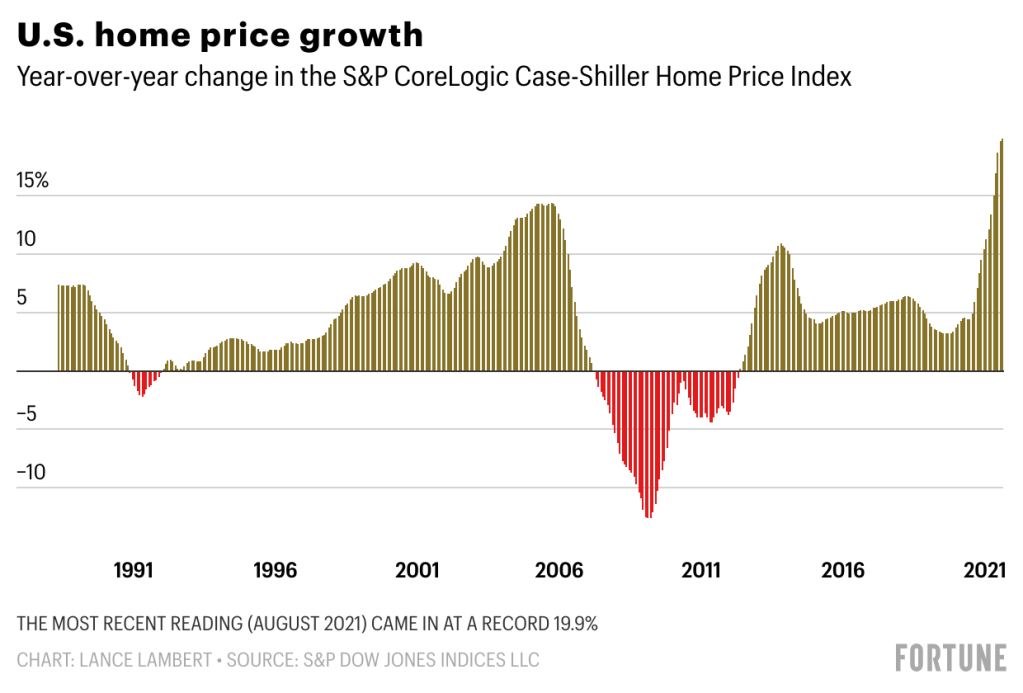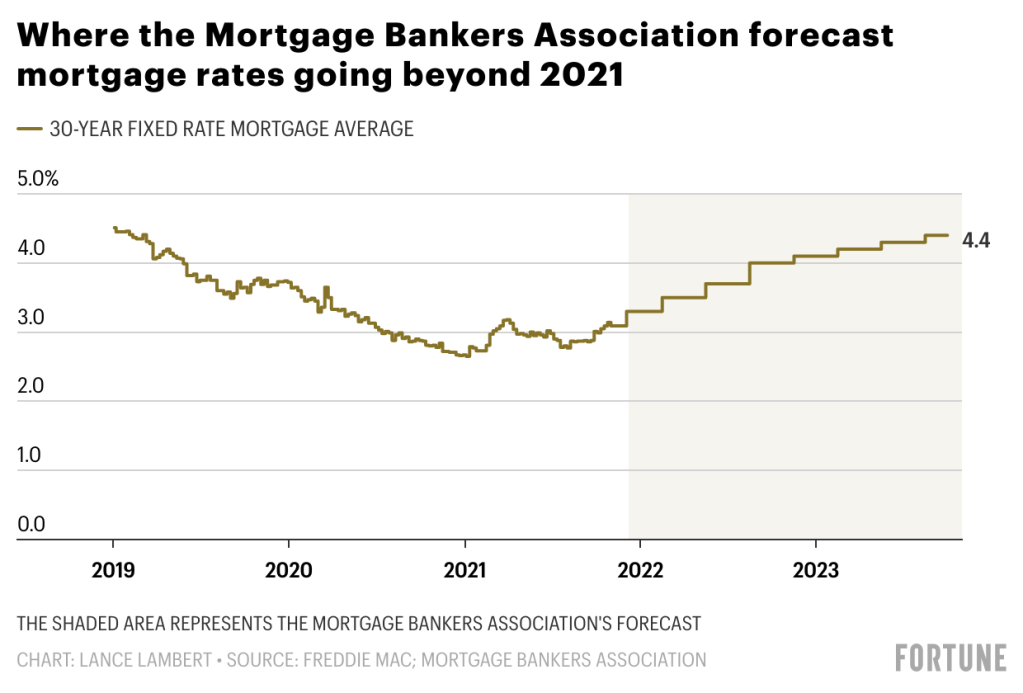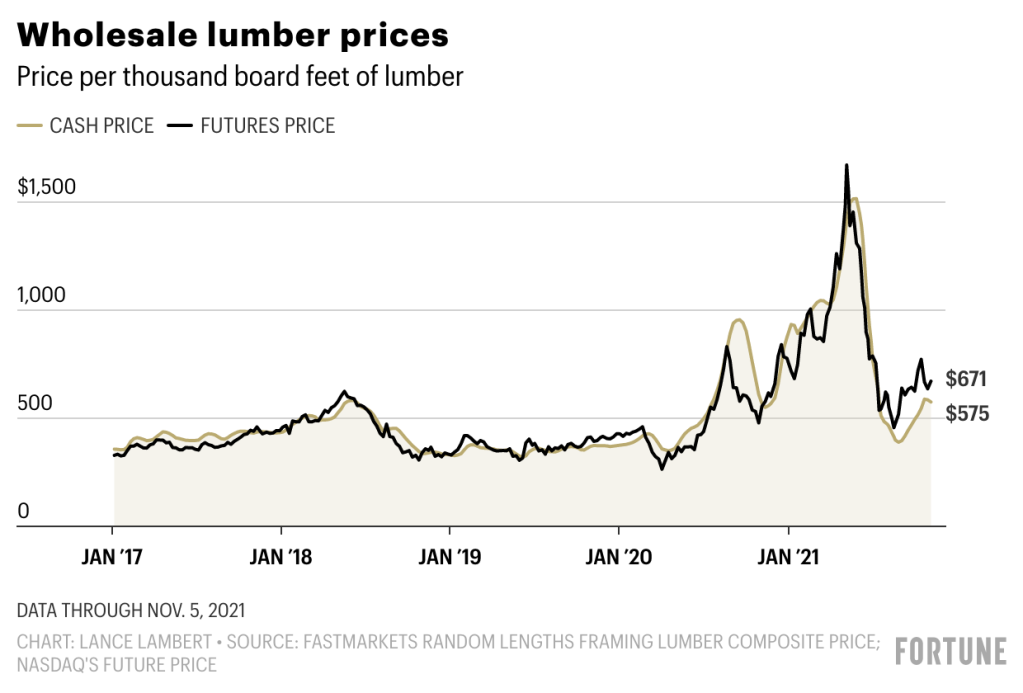今年的美國房地產市場對購房者來說堪稱噩夢。今年,美國房地產市場的庫存降到了40年來的最低水平。所以即便購房者可以找到預算范圍內的房源,他們也很有可能在競價大戰中輸給別人。這種說法一點也不夸張,今年春天,美國一度有74%的房源都存在多個買家競購的現象。
不過好消息是,2022年,美國住房市場或許不會重現今年的瘋漲勢頭了。從去年8月到今年8月,美國房價的漲幅達到了創紀錄的19.9%。不過《財富》雜志看到的所有預測模型都表明,明年美國的房價增幅將有所放緩(也就是不會增長得這么快)。現在我們已經看到美國房市有了降溫跡象。首先是競購。到今年9月,有多個買家競購的房源數已經下降到59%,也就是比4月下降了15個百分點。
不過有業內人士表示,雖然美國房市已經告別了飛速增長時期,但是就下一階段的房價將往何處去,業界尚未形成共識,對2022年房地產市場的展望也是眾說紛紜。有些機構對房市表示看好,比如Zillow公司預測,未來12個月,美國房價還將上漲13.6%;高盛集團(Goldman Sachs)認為美國房價到2022年年底前還將上漲16%。房利美(Fannie Mae)則不那么樂觀,認為2022年的房價只會上漲7.9%。也有些機構并不看好明年的美國房市,例如CoreLogic公司認為,未來12個月,美國的房價增幅將只有1.9%。如果Zillow和高盛集團預測準確的話,那么明年就將是有史以來美國房市最火熱的一年。如果CoreLogic的預測成為現實,那明年就將是自2012年以來美國房價增長最緩慢的一年。

這些預測相差如此之大,不禁令人發問:為什么2022年的美國房市有這么多的不確定性?
從紙面上看,特別是從供需關系上看,2022年美國房地產市場的基本面還是相當強勁的。不過有業內人士對《財富》雜志表示,由于兩大不確定因素的存在,我們很難準確評估明年這種供需關系不平衡的程度。
1. 明年的按揭利率會漲多少?
去年歲末年初之際,美聯儲(Federal Reserve)曾經預測道,今年的通脹將會相對溫和,最高不會超過1.8%。然而事實是如此“打臉”。根據10月的最新數據,美國的消費價格指數已經達到6.2%——也就是自1990年以來最高的通脹。20世紀70年代是有名的“通脹失控的十年”,平均通脹水平大約是7.1%,而今年美國的通脹水平已經與20世紀70年代相差無幾了。
自從新冠疫情爆發以來,美聯儲基本上保持了凈零利率以刺激經濟。但是鑒于出現了通脹高于預期的情況,美聯儲很有可能通過加息進行調控。只要美聯儲一加息,30年期的固定按揭貸款利率(目前大約為2.98%)也會水漲船高。高按揭利率意味著高月供,很多購房者很可能因此而打消買房的念頭。
約翰·伯恩斯房地產咨詢公司(John Burns Real Estate Consulting)的研究副總裁德溫·巴赫曼對《財富》雜志說:“如果按揭利率出現變化,它對各方面就都會產生影響……按揭利率是一個不確定因素,它與住房市場方方面面的行為都有直接關系。”

但是,目前房地產業仍然不確定按揭貸款利率會上漲多少。
據房利美推測,到明年年底,美國的30年期按揭貸款的平均利率有可能會上漲到3.4%。而美國抵押貸款銀行家協會(Mortgage Bankers Association)則認為會漲到4%,而且到2023年年底,還會進一步上漲至4.4%。
有人可能認為,這點加息幅度并不算大,實際并非如此。舉個例子,一位購房者首付20%,買了一套總價50萬美元的房子。如果他按照當前的按揭利率還款(2.98%),他每月的月供(不含稅和保險)就是1682美元。但如果按揭利率上漲到3.4%,他的月供就會達到1774美元。如果漲到4%,他的月供就會上漲到1910美元,折算成30年,就是要為這套房子多掏82000美元。
2. 供應鏈問題是否影響開工?
美國的房子會大量用到木材。而今年春天,美國的木材價格一度上漲到新冠疫情前的300%。木材的價格波動只是一個縮影,它背后是美國經濟各行各業都面臨的材料短缺和供應鏈壓力。最終,隨著DIY愛好者在高價格面前放棄了自己打家具,美國的木材價格有所回落。你可能會想,既然木材降價了,新房價格肯定也會跟著降價吧?事實遠非如此。光是在過去的四個月里,美國的新房價格就又上漲了5%。
為什么會這樣?答案是,雖然木材短缺的問題有所緩解,但是從水泥、窗戶到油漆等其他所有原材料的價格都在飆升。
巴赫曼說:“木材的價格已經下來了,我們有了更多的木材,但這并不意味著我們有了更多的家具和櫥柜。”更不用說建筑業的離職潮給新房建設帶來的沖擊了。“勞動力問題又開始抬頭了。越來越多的建筑公司都在抱怨招工難的問題。因為招工難,很多工地無法按時交工,原因就是沒有足夠的勞動力。”

木材價格的下調也很難說是什么好的征兆。今年春天,美國木材價格一度達到每千板英尺1515美元,隨著DIY愛好者們開始“躺平”,木材價格也在8月中旬回落到389美元。但現在DIY愛好者又活躍起來了,美國的木材價格也再次攀升至575美元。當然和1515美元相比,現在的木材價格還算便宜,但顯然還是遠遠高于2020年年初的375美元。
比起原材料短缺和供應鏈問題,更令人不安的是,《財富》雜志采訪的所有業內人士都不知道通脹和勞動力短缺問題何時能夠得到解決。
不過,按揭利率上漲得太快的話,一般會導致房價下行。而新房建設的開工率不足的話,一般只會導致房價漲得更高。目前,美國大約有400萬套新房在建,而“千禧一代”中的大多數人已經到了首次買房的年紀。如果開工率進一步下降(今年9月只開工了155萬套,已經顯著低于3月的173萬套),這就意味著本就緊張的房源將變得更加緊張,購房者之間的競爭也將更加激烈。
行業媒體Fastmarkets Random Lengths的肖恩·丘奇告訴《財富》雜志:“現在有很多人擔心,在通脹的壓力下,加上宏觀經濟面臨的各種威脅,美國的新房建設速度還能否保持2021年的水平。”(財富中文網)
譯者:樸成奎
今年的美國房地產市場對購房者來說堪稱噩夢。今年,美國房地產市場的庫存降到了40年來的最低水平。所以即便購房者可以找到預算范圍內的房源,他們也很有可能在競價大戰中輸給別人。這種說法一點也不夸張,今年春天,美國一度有74%的房源都存在多個買家競購的現象。
不過好消息是,2022年,美國住房市場或許不會重現今年的瘋漲勢頭了。從去年8月到今年8月,美國房價的漲幅達到了創紀錄的19.9%。不過《財富》雜志看到的所有預測模型都表明,明年美國的房價增幅將有所放緩(也就是不會增長得這么快)。現在我們已經看到美國房市有了降溫跡象。首先是競購。到今年9月,有多個買家競購的房源數已經下降到59%,也就是比4月下降了15個百分點。
不過有業內人士表示,雖然美國房市已經告別了飛速增長時期,但是就下一階段的房價將往何處去,業界尚未形成共識,對2022年房地產市場的展望也是眾說紛紜。有些機構對房市表示看好,比如Zillow公司預測,未來12個月,美國房價還將上漲13.6%;高盛集團(Goldman Sachs)認為美國房價到2022年年底前還將上漲16%。房利美(Fannie Mae)則不那么樂觀,認為2022年的房價只會上漲7.9%。也有些機構并不看好明年的美國房市,例如CoreLogic公司認為,未來12個月,美國的房價增幅將只有1.9%。如果Zillow和高盛集團預測準確的話,那么明年就將是有史以來美國房市最火熱的一年。如果CoreLogic的預測成為現實,那明年就將是自2012年以來美國房價增長最緩慢的一年。
這些預測相差如此之大,不禁令人發問:為什么2022年的美國房市有這么多的不確定性?
從紙面上看,特別是從供需關系上看,2022年美國房地產市場的基本面還是相當強勁的。不過有業內人士對《財富》雜志表示,由于兩大不確定因素的存在,我們很難準確評估明年這種供需關系不平衡的程度。
1. 明年的按揭利率會漲多少?
去年歲末年初之際,美聯儲(Federal Reserve)曾經預測道,今年的通脹將會相對溫和,最高不會超過1.8%。然而事實是如此“打臉”。根據10月的最新數據,美國的消費價格指數已經達到6.2%——也就是自1990年以來最高的通脹。20世紀70年代是有名的“通脹失控的十年”,平均通脹水平大約是7.1%,而今年美國的通脹水平已經與20世紀70年代相差無幾了。
自從新冠疫情爆發以來,美聯儲基本上保持了凈零利率以刺激經濟。但是鑒于出現了通脹高于預期的情況,美聯儲很有可能通過加息進行調控。只要美聯儲一加息,30年期的固定按揭貸款利率(目前大約為2.98%)也會水漲船高。高按揭利率意味著高月供,很多購房者很可能因此而打消買房的念頭。
約翰·伯恩斯房地產咨詢公司(John Burns Real Estate Consulting)的研究副總裁德溫·巴赫曼對《財富》雜志說:“如果按揭利率出現變化,它對各方面就都會產生影響……按揭利率是一個不確定因素,它與住房市場方方面面的行為都有直接關系。”
但是,目前房地產業仍然不確定按揭貸款利率會上漲多少。
據房利美推測,到明年年底,美國的30年期按揭貸款的平均利率有可能會上漲到3.4%。而美國抵押貸款銀行家協會(Mortgage Bankers Association)則認為會漲到4%,而且到2023年年底,還會進一步上漲至4.4%。
有人可能認為,這點加息幅度并不算大,實際并非如此。舉個例子,一位購房者首付20%,買了一套總價50萬美元的房子。如果他按照當前的按揭利率還款(2.98%),他每月的月供(不含稅和保險)就是1682美元。但如果按揭利率上漲到3.4%,他的月供就會達到1774美元。如果漲到4%,他的月供就會上漲到1910美元,折算成30年,就是要為這套房子多掏82000美元。
2. 供應鏈問題是否影響開工?
美國的房子會大量用到木材。而今年春天,美國的木材價格一度上漲到新冠疫情前的300%。木材的價格波動只是一個縮影,它背后是美國經濟各行各業都面臨的材料短缺和供應鏈壓力。最終,隨著DIY愛好者在高價格面前放棄了自己打家具,美國的木材價格有所回落。你可能會想,既然木材降價了,新房價格肯定也會跟著降價吧?事實遠非如此。光是在過去的四個月里,美國的新房價格就又上漲了5%。
為什么會這樣?答案是,雖然木材短缺的問題有所緩解,但是從水泥、窗戶到油漆等其他所有原材料的價格都在飆升。
巴赫曼說:“木材的價格已經下來了,我們有了更多的木材,但這并不意味著我們有了更多的家具和櫥柜。”更不用說建筑業的離職潮給新房建設帶來的沖擊了。“勞動力問題又開始抬頭了。越來越多的建筑公司都在抱怨招工難的問題。因為招工難,很多工地無法按時交工,原因就是沒有足夠的勞動力。”
木材價格的下調也很難說是什么好的征兆。今年春天,美國木材價格一度達到每千板英尺1515美元,隨著DIY愛好者們開始“躺平”,木材價格也在8月中旬回落到389美元。但現在DIY愛好者又活躍起來了,美國的木材價格也再次攀升至575美元。當然和1515美元相比,現在的木材價格還算便宜,但顯然還是遠遠高于2020年年初的375美元。
比起原材料短缺和供應鏈問題,更令人不安的是,《財富》雜志采訪的所有業內人士都不知道通脹和勞動力短缺問題何時能夠得到解決。
不過,按揭利率上漲得太快的話,一般會導致房價下行。而新房建設的開工率不足的話,一般只會導致房價漲得更高。目前,美國大約有400萬套新房在建,而“千禧一代”中的大多數人已經到了首次買房的年紀。如果開工率進一步下降(今年9月只開工了155萬套,已經顯著低于3月的173萬套),這就意味著本就緊張的房源將變得更加緊張,購房者之間的競爭也將更加激烈。
行業媒體Fastmarkets Random Lengths的肖恩·丘奇告訴《財富》雜志:“現在有很多人擔心,在通脹的壓力下,加上宏觀經濟面臨的各種威脅,美國的新房建設速度還能否保持2021年的水平。”(財富中文網)
譯者:樸成奎
This year was an absolute nightmare for would-be homebuyers. Even if they could find a home within their budget—no easy task as inventory hit a 40-year low this year—there’s a good chance they lost it in a frenzied bidding war. That’s not an exaggeration: At one point this spring, a staggering 74% of U.S. home listings were getting multiple offers.
But there might be a tiny bit of good news for house hunters: The industry consensus is that the 2022 housing market will see less crazy price hikes. Every forecast model Fortune has reviewed shows price growth—which soared a record 19.9% between August 2020 and August 2021—decelerating (a.k.a. not going up as fast) next year. Already, we’re starting to see some of that cooling. Look no further than bidding wars. As of September, 59% of homes are getting multiple offers, or a 15 percentage point drop from April.
However, while industry insiders say we’re transitioning into a period where price growth isn’t as astronomical, there’s no consensus on what that new rate of price growth will look like. Indeed, when it comes to the 2022 housing market, the outlooks are all over the place. On the high end, there is Zillow, which is forecasting 13.6% price growth in the coming 12 months, and Goldman Sachs, which predicts a 16% bump by the end of 2022. Fannie Mae is less bullish, saying prices will climb 7.9% in 2022. Meanwhile, CoreLogic is pretty bearish in forecasting just a 1.9% price jump over the coming 12 months. If Zillow or Goldman Sachs are right, that would mean 2022 would still be among the hottest years on record. If CoreLogic’s forecast turns into reality, then we would be headed for the slowest period for price growth since 2012.
These wide-ranging forecasts prompt the question: Why is there so much uncertainty when it comes to the 2022 housing market?
On paper, the fundamentals underpinning the market—demand outpacing supply—remain strong heading into 2022. However, industry insiders tell Fortune two big unknowns make it hard to pinpoint just how big that demand and supply mismatch will be next year.
1. How high will mortgage rates climb in 2022
Heading into 2021, the Federal Reserve predicted that inflation would remain relatively tame and that it would top out at 1.8% this year. Boy, were they wrong. At its latest reading for the month of October, the consumer price index came in at 6.2%—the highest rate of inflation since 1990. That’s barely below the 7.1% average inflation rate notched during the 1970s, a decade notorious for runaway inflation.
Higher than expected inflation makes it all the more likely that the Federal Reserve would raise the federal funds rate—something it has kept near zero during the pandemic in an effort to encourage more economic activity. But if the Federal Reserve does raise rates, it would also see the average 30-year fixed mortgage rate (currently at 2.98%) rise. Of course, upped mortgage rates directly translate into higher monthly payments—which would lock some buyers out of the market altogether.
“If something changes in the mortgage rate environment, that could throw a massive wrench in everything…Mortgage rates are a bit of an unknown, and they have a direct relation with activity in the housing market,” Devyn Bachman, vice president of research at John Burns Real Estate Consulting, told Fortune.
But the industry isn’t quite sure how high rates will rise.
Fannie Mae foresees the average 30-year rate climbing to 3.4% by the end of next year. Meanwhile, the Mortgage Bankers Association is forecasting that the mortgage rate will climb to 4% by the end of 2022, and to 4.4% by the end of 2023.
Those forecasted rate increases are bigger than they might look. For instance, say a buyer put down 20% on a $500,000 home. If she locked in the current average 30-year rate (2.98%), she would have a monthly payment (excluding taxes and insurance) of $1,682. But if the mortgage rate is 3.4%, it pushes the monthly payment to $1,774. At the 4% rate level forecasted by the Mortgage Bankers Association, that payment spikes all the way to $1,910, or an additional $82,000 over the course of 30 years.
2. Will supply chain shortages hold back homebuilders in 2022?
Lumber, which was up 300% this spring above its pre-pandemic price, was arguably the canary in the coal mine for the material shortages and supply chain issues that are plaguing the economy. Ultimately, framing lumber prices started to crash back in May as do-it-yourselfers simply balked at the exorbitant prices. That price correction obviously brought down the price of new homes, right? Not even close. Over the past four months alone new-home prices are up another 5%.
What’s going on? While the wood shortage has eased, the price of almost every other building component has shot up. Concrete. Windows. Paint. You name it, the price is up.
“Lumber has come down; we have more lumber. But that does not mean we have more appliances or cabinets,” Bachman noted. Not to mention, the Great Resignation has hit the construction industry fairly hard. “Labor is starting to rear its ugly head again, and we’re hearing a lot more conversations about ‘I can’t find workers. I can’t get [the work done] on time. There’s not enough labor,’” Bachman said.
Even the correction in the lumber market is hardly a silver lining. After peaking at $1,515 per thousand board feet this spring, lumber prices crashed to $389 by mid-August as DIY buyers sat on the sideline. But now those buyers are rushing back in, helping to send the price back to $575. That might seem cheap compared with the top of the lumber bubble. However, it’s still well above the $375 price builders were paying heading into 2020.
What’s more troubling than the lack of material or supply chain relief is the fact that industry insiders interviewed by this publication don’t have any idea of when—or how—inflationary spikes and labor shortages will get resolved.
Unlike with mortgage rates, which threaten to decelerate prices if they’re upped too fast, homebuilding cutbacks threaten to send prices higher. It boils down to the fact the U.S. is under-built by 4 million homes as the largest chunk of millennials are hitting their peak first-time homebuying years. If builders are forced to scale back further (the 1.55 million housing starts in September are already below the 1.73 million starts in March), it could mean even fewer homes for sale in an already historically tight—and competitive—housing market.
“There is some concern about whether homebuilding can sustain its 2021 pace amid inflationary pressures and various threats to the economy,” Shawn Church, editor at Fastmarkets Random Lengths, told Fortune.






